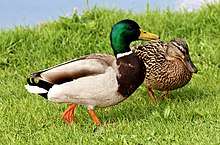Pair bond

In biology, a pair bond is the strong affinity that develops in some species between a pair consisting of a male and female, or in some cases as a same-sex pairing, potentially leading to producing offspring and/or a lifelong bond. Pair-bonding is a term coined in the 1940s[1] that is frequently used in sociobiology and evolutionary biology circles. The term often implies either a lifelong socially monogamous relationship or a stage of mating interaction in socially monogamous species. It is sometimes used in reference to human relationships.
Monogamous voles, such as prairie voles, have significantly greater density and distribution of vasopressin receptors in their brain when compared to polygamous voles. These differences are located in the ventral forebrain and the dopamine-mediated reward pathway.
Peptide arginine vasopressin (AVP), dopamine, and oxytocin act in this region to coordinate rewarding activities such as mating, and regulate selective affiliation. These species-specific differences have shown to correlate with social behaviors, and in monogamous prairie voles are important for facilitation of pair bonding. When compared to montane voles, which are polygamous, monogamous prairie voles appear to have more of these AVP and oxytocin neurotransmitter receptors. It is important that these receptors are in the reward centers of the brain because that could lead to a conditioned partner in the prairie vole compared to the montane vole which would explain why the prairie vole forms pair bonds and the montane vole does not.[2][3]
Varieties

According to evolutionary psychologists David P. Barash and Judith Lipton, from their 2001 book The Myth of Monogamy, there are several varieties of pair bonds:[4]
- Short-term pair-bond: a transient mating or associations
- Long-term pair-bond: bonded for a significant portion of the life cycle of that pair
- Lifelong pair-bond: mated for life
- Social pair-bond: attachments for territorial or social reasons, as in cuckold situations
- Clandestine pair-bond: quick extra-pair copulations
- Dynamic pair-bond: e.g. gibbon mating systems being analogous to "swingers"
Humans and pair bonding
Humans can experience some or all of the above-mentioned varieties of pair bonds in their lifetime. These bonds can be temporary or last a lifetime, same age or with different age groups. In a biological sense there are two main types of pair bonds exhibited in humans: social pair bonding and sexual pair bonding. The social pair bond is a strong behavioral and psychological relationship between two individuals that is measurably different in physiological and emotional terms from general friendships or other acquaintance relationships. On the other hand, the sexual pair bond is a behavioral and physiological bond between two individuals with a strong sexual attraction component. In this bond the participants in the sexual pair bond prefer to have sex with each other over other options. Social pair bonds are usually more wide-ranging than their sexual counterparts due to the sexual nature involved in the latter. In humans and other mammals, these pair bonds are created by a combination of social interaction and biological factors including neurotransmitters like oxytocin, vasopressin, and dopamine.
Pair bonds (social and/or sexual) do not equal marriage. Marriage can be associated with sexual and social pair bonds; however, married couples do not necessarily have to experience both or either of these bonds. Marriage can be a consequence of pair bonding and vice versa; however, neither always creates or leads to the other. Pair bonding in humans helps explain extreme "bonds" that we may share with others but are unable to articulate in terms of contemporary "love".[5]
Examples
Birds
Close to ninety percent[6] of birds are “monogamous”, which is significant compared to the only five percent of mammals that are classified as such. This is not to mean they stay together forever. Some do, such as swans, some cranes and geese. There are more specific examples, such as bald eagles, California condors and the Atlantic Puffin.[7] Those are just some examples of the other "10%" though. The other large percentage of pair bond in birds would be classified under a long-term pair bond which is seasonal. These species breed, raise their young then pair up with a new mate the next season. When discussing the social life of the bank swallow, Lipton and Barash state:[4]
For about four days immediately prior to egg-laying, when copulations lead to fertilizations, the male bank swallow is very busy, attentively guarding his female. Before this time, as well as after—that is, when her eggs are not ripe, and again after his genes are safely tucked away inside the shells—he goes seeking extra-pair copulations with the mates of other males…who, of course, are busy with defensive mate-guarding of their own.

In various species, males provide parental care and females mate with multiple males. For example, recent studies show that extra-pair copulation frequently occurs in monogamous birds in which a "social" father provides intensive care for its "social" offspring.[8]
Fishes
A University of Florida scientist reports that male sand gobies work harder at building nests and taking care of eggs when females are present – the first time such “courtship parental care” has been documented in any species.[9]
In the cichlid species Tropheus moorii, a male and female will form a temporary monogamous pair bond and spawn; after which, the female leaves to mouthbrood the eggs on her own. T. moorii broods exhibit genetic monogamy (all eggs in a brood are fertilized by a single male).[10] Another mouth brooding cichlid - the Lake Tanganyika cichlid (Xenotilapia rotundiventralis) has been shown that mating pairs maintain pair bonds at least until the shift of young from female to male. [11] More recently the Australian Murray cod has been seen maintaining pair bonds over 3 years [12]
Mammals
As noted above, different species of voles vary in their sexual behavior, and these differences correlate with expression levels of vasopressin receptors in reward areas of the brain. Scientists were able to change adult male montane voles' behavior to resemble that of monogamous prairie voles in experiments in which vasopressin receptors were introduced into the brain of male montane voles.
See also
References
- ↑ "Pair-bond". Oxford English Dictionary. 2005.
- ↑ Young, Larry J. (24 April 2018). "The Neural Basis of Pair Bonding in a Monogamous Species: A Model for Understanding the Biological Basis of Human Behavior". National Academies Press (US). Archived from the original on 6 February 2018. Retrieved 24 April 2018 – via www.ncbi.nlm.nih.gov.
- ↑ Lim MM, Wang Z, Olazábal DE, Ren X, Terwilliger EF, Young LJ (June 2004). "Enhanced partner preference in a promiscuous species by manipulating the expression of a single gene". Nature. 429 (6993): 754–7. doi:10.1038/nature02539. PMID 15201909.
- 1 2 Barash, D.; Lipton, J. (2001). The Myth of Monogamy: Fidelity and Infidelity in Animals and People. New York: Henry Holt and Company. ISBN 0805071369.
- ↑ "On Marriage and Pair Bonds". Psychology Today. Retrieved 24 April 2018.
- ↑ Young, Larry J. (11 June 2018). "The Neural Basis of Pair Bonding in a Monogamous Species: A Model for Understanding the Biological Basis of Human Behavior". National Academies Press (US). Archived from the original on 6 February 2018. Retrieved 11 June 2018 – via www.ncbi.nlm.nih.gov.
- ↑ Berger, Michele (11 June 2018). "Till Death do them Part: 8 Birds that Mate for Life". National Academies Press (US). Retrieved 11 June 2018 – via www.audubon.org.
- ↑ "New Study Explores The Evolution Of Male Parental Care And Female Multiple Mating". ScienceDaily. Archived from the original on 2015-09-05.
- ↑ "For A Male Sand Goby, Playing 'Mr. Mom' Is Key To Female's Heart". ScienceDaily. Archived from the original on 2016-03-05.
- ↑ Steinwender, Bernd, Stephan Koblmüller, and Kristina M. Sefc. "Concordant Female Mate Preferences in the Cichlid Fish Tropheus Moorii". Hydrobiologia 682.1 (2011): n. pag. 31 May 2011. Web. 22 October 2013.
- ↑ Tetsumi Takahashi; Haruki Ochi; Masanori Kohda; Michio Hori (2012). "Invisible pair bonds detected by molecular analyses". Biology Letters. 8: 355-357. doi:10.1098/rsbl.2011.1006. PMC 3367736.
- ↑ Couch AJ; Dyer FJ; Lintermans M. (2018). "Multi-year pair-bonding in Murray cod (Maccullochella peelii)". PeerJ Preprints. 6:e27032v1. doi:10.7287/peerj.preprints.27032v1.